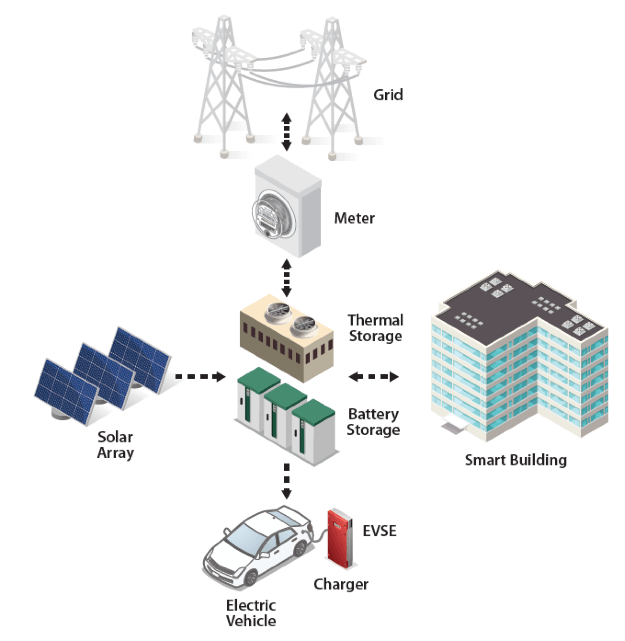Behind-the-Meter Storage Consortium
The Behind-the-Meter Storage (BTMS) Consortium focuses on energy storage technologies that minimize costs and grid impacts by integrating electric vehicle (EV) charging, solar photovoltaic (PV) generation, and energy-efficient buildings using controllable loads.
The consortium consists of a multidisciplinary team that researches the integration of these energy system technologies, considering all aspects of the system—from analysis to materials, full system design, and controls. The team develops innovative control strategies—for seamless interaction between these distributed energy systems—by developing new battery storage solutions that can perform at high power for excellent EV charging efficiency but also recharge from the grid at standard lower rates.
Next-generation thermal storage materials and solutions are also being developed. These materials solutions are being integrated into systems at scales that will enable experimental validation of both control models and cost analysis.
The BTMS Consortium focuses on research at a low-technology readiness level but is guided by system-level thinking.

Applications
The BTMS Consortium develops energy storage technologies for stationary applications less than 10 megawatt-hours to:
- Enable extreme fast-charging of EVs
- Optimally integrate PV generation from a DC–DC connection
- Couple electrochemical and thermal storage
- Increase energy efficiency of buildings
- Eliminate potential grid impacts of high-power EV charging systems
- Lower installation costs to the consumer.
Research Team
NREL leads BTMS Consortium research, which involves scientists and engineers from across NREL as well as from other U.S. Department of Energy laboratories, including Idaho National Laboratory, Sandia National Laboratories, and Argonne National Laboratories.
The consortium’s research is funded by the Department of Energy Vehicle Technologies Office, Building Technologies Office, and Solar Energy Technologies Office.
NREL’s Consortium Research
NREL researchers are involved in numerous aspects of BTMS Consortium research. For more information, see energy storage research.
Thermal Storage
NREL develops and characterizes building thermal energy storage materials, devices, and systems and leverages multiscale models to innovate novel ways to integrate them into building components. The BTMS Consortium can leverage this expertise to understand how adding thermal storage to building structures or thermal equipment impacts flexibility, resilience, and energy use. The BTMS Consortium can also characterize the energy capacity, power, lifetime, or efficiency of existing thermal storage technologies. The modeling and experimental capabilities span milligram materials to full-scale components and systems with integrated thermal storage.
Contacts: Jason Woods and Judith Vidal
Grid-Interactive Efficient Buildings
NREL’s research in controllable building loads—including cooling, heating, refrigeration, and plug and process—focuses on how these loads can integrate with BTMS to provide controlled energy flow and meet demand across distributed energy resources. The BTMS Consortium taps into NREL’s characterization of the latest components and integrated systems, development and evaluation of supervisory controls, and multiscale modeling and analysis.
Contacts: Jason Woods and Bill Livingood
Battery Storage
NREL's stationary battery storage research focuses on how to integrate high-performance stationary battery technologies into the grid and test more efficient materials for BTMS and other large-scale, long-life energy storage technologies. NREL is a recognized leader in materials science, providing comprehensive evaluation of the thermal and electrical behavior of batteries at the cell, module, pack, and system level. One of the key features of the energy storage work at NREL is the development of physics-based lifetime models, in collaboration with Idaho National Laboratory, that enable developers to accurately predict the total operating cost of battery based energy storage. The BTMS Consortium leverages NREL's expertise to measure how an EV battery’s behavior, capacity, life span, and performance impact its integration with other vehicle components and the larger energy system. This NREL capability is complemented by the advanced materials and cell work at Argonne National Laboratory, the system analysis and testing capabilities of Idaho National Laboratory, and the safety and design capabilities of Sandia National Laboratories.
Contact: Anthony Burrell
Vehicles and Buildings Integration Capability
NREL's Energy Systems Integration Facility houses the Vehicles and Buildings Integration Capability, a one-of-a-kind research space that combines the energy resources of commercial buildings, energy storage equipment, and an EV test bed to test how different loads can provide flexible energy flow to the grid and reduce overall energy consumption while maintaining a comfortable atmosphere for building occupants. The Vehicles and Buildings Integration Capability provides the BTMS consortium with research capabilities for commercial buildings integration, BTMS, and EV grid integration that is unique in the national laboratory complex.
For more information, see commercial buildings research infrastructure.
Contacts: Grant Wheeler and Andrew Meintz
Energy Storage Analysis
NREL researchers analyze energy storage related to decision-making and impacts for industry stakeholders at all scales. This research focus enables the BTMS Consortium to analyze automotive, distribution, and transmission grid applications as well as storage system design and optimization and component development.
Contact: Margaret Mann
Contact
Anthony Burrell
Energy Storage
Share

